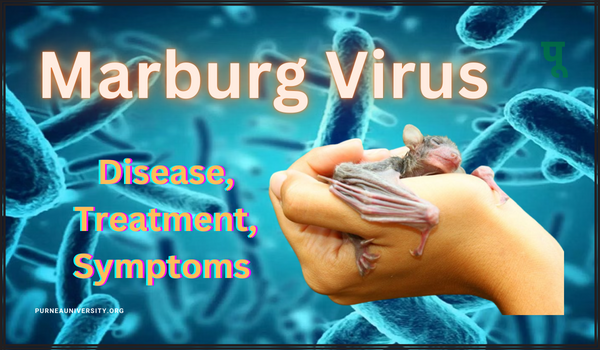Marburg Virus Disease, Treatment, Symptoms, Origin, Vaccine, Outbreak
Marburg Virus Disease, Treatment, Symptoms, Origin, Vaccine, Outbreak and all other details regarding this virus is in this article. Marburg Virus Disease (MVD) is a rare and severe hemorrhagic fever caused by the Marburg virus, a member of the Filoviridae family. It was first identified in 1967 when outbreaks of a mysterious disease occurred simultaneously in Germany and Yugoslavia.
Marburg Virus Disease
In some cases, the organs may become affected, and the patient can experience jaundice, abdominal pain, and vomiting. Death can occur in up to 25% of cases. Treatment is mostly supportive and includes the administration of fluids, electrolytes, and blood transfusions.
|
Important Links |
Vaccines and antiviral medications are currently under development, but there is no effective treatment or cure for MVD. It is highly contagious and can spread through contact with bodily fluids and secretions, as well as through aerosolized droplets, so it is important to practice good hygiene and take protective measures such as wearing masks and gloves when dealing with potential MVD cases.
Marburg Virus Treatment
Treatment for MVD is currently limited to supportive care, such as providing fluids and electrolytes, maintaining oxygen levels and blood pressure, and treating any complicating infections. There is no specific antiviral treatment available for MVD. Patients who are severely ill may benefit from intensive supportive care, including mechanical ventilation and other advanced supportive therapies. It is also essential to identify any secondary bacterial infections and treat them with antibiotics.
In addition, it is important to prevent the spread of the virus. This includes isolating the patient, wearing protective clothing, and practising regular hand hygiene. Healthcare workers should follow standard, contact and droplet precautions when caring for patients with MVD. Finally, it is crucial to ensure that the patient has access to psychological and social support. This can help to reduce stress and anxiety and improve quality of life.
Marburg Virus Symptoms
Symptoms of MVD typically begin with fever, chills, headache, and malaise. As the disease progresses, the patient may develop severe abdominal pain, nausea, vomiting, chest pain, sore throat, and a rash. In some cases, infected individuals may experience bleeding from the nose, mouth, eyes, or other areas of the body.
Rare cases include bleeding in the brain may occur. In the most severe cases, the patient may develop shock, liver failure, and multi-organ failure. Treatment is supportive and may include fluids, electrolytes, and oxygen therapy. In some cases, antiviral medications may be used to help improve the patient’s chances of recovery.
Marburg Virus Origin
Marburg virus disease (MVD) is a rare and often fatal hemorrhagic fever, which is caused by the Marburg virus (MARV), a member of the Filoviridae family. It was first identified in 1967 when two laboratory workers in Marburg, Germany, were infected after being exposed to infected African Green monkeys. The disease has since been identified in Africa, Europe, and Central and South America.
The virus can be spread from person to person through direct contact with an infected person’s bodily fluids, such as blood, saliva, or vomit. It can also be spread by contact with an infected animal, such as a bat, monkey, or rat. There is no specific treatment for MVD, but supportive care can help to reduce the symptoms and improve the patient’s chance of survival.
Marburg Virus Vaccine
Marburg Virus disease vaccine is not yet available. Currently, research is ongoing to develop a safe and effective vaccine. Vaccine development involves testing different vaccine formulations, such as recombinant vaccines, virus-like particles, and live attenuated viruses, in animal models.
Once a promising vaccine candidate is identified, clinical trials must be conducted to evaluate its safety and efficacy in humans. Vaccine development is a complex and lengthy process involving collaboration between public and private organizations, and the production and distribution of a Marburg virus disease vaccine may take years.
Marburg Virus Outbreak
Marburg virus disease is an often fatal hemorrhagic fever virus. It is a zoonotic virus, meaning it is primarily spread through contact with infected animals. Outbreaks occur sporadically in parts of Africa. Treatment is mainly supportive and includes providing fluids, electrolytes, and medications to reduce fever and pain.
Vaccines are not currently available. Prevention includes avoiding contact with infected animals, wearing protective clothing when handling wild animals, and avoiding contact with the blood and body fluids of people who are infected.
If you have any confusion regarding Marburg virus disease, symptoms or treatment, then you can ask it by commenting in the comment box below.

